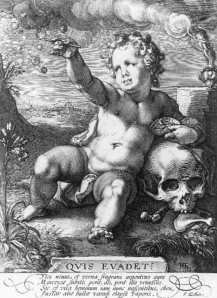Vanitas -atis f. (Latin)
Emptiness, worthlessness, unreality, boasting, ostentation.
Vain/ [veyn] –adjective, -er, -est.
1. Ineffectual or unsuccessful; futile: a vain effort.
2. Without real significance, value, or importance; baseless or worthless: vain pageantry; vain display.
3. Archaic. Senseless or foolish.
Van·i·ty [van-i-tee] noun, plural -ties
1.Excessive pride in one’s appearance, qualities, abilities, achievements, etc.; character or quality of being vain; conceit.
2.Lack of real value; hollowness; worthlessness: the vanity of a selfish life.
3.Something worthless, trivial, or pointless.
December has arrived, and with it, many things come to end. It’s funny how every year the same thing happens (I swear! December comes every year) and I still can’t get used to it. Here we are… the candle’s gone out, yet again, reminding us that we are getting older while time flies.
These past few months have been hectic and I have therefore neglected the blog a little bit; so I thought the finishing of my first year of the Art History course I took was the best excuse to deoxidize my writing. I thought: “Out of all that I’ve studied… What really made an impression or surprised me?” Two things came to mind: The Roman catacombs from the third and fourth centuries and the seventeenth century Vanitas… which shouldn’t come as a surprise considering how I recurrently feel captivated by symbolist or allusive content in art.
Anyway, this is why vanitas (some better known as Still Life) surprised me: apparently, there’s more to them than random stuff scattered around in the shadows.
Vanitases talk about the futility and shortness of earthly life and symbolize how death will eventually come and take every one of us without discriminating.
QUIS EVADET? Who avoids it (death)?
I guess I myself had never really thought about vanity as futility…huh…
To depict and symbolize our brief time on earth, several elements were used:
- Soap bubbles, antique ruins, withering flowers, candles going out, smoke and wind stand for how ephemeral things can be.
- Skulls and skeletons represent death
- Mirrors show how the reflected image is always altered from reality
- Clocks and snakes are time
- Books, scientific instruments, materials and tools, jewels, crowns, weapons, vases, cards, musical instruments, represent our earthly existence
- And finally, spikes symbolize the resurrection
Life was being reevaluated.
‘What does it all mean?’ ‘Why are we here?’ ‘What are we here for if everything eventually goes away?’ Leonardo quotes Ovid when he says: ‘Devouring Time, and you, jealous Age, consume everything, and slowly gnawing at them, with your teeth, little by little, consign all things to eternal death!’(1). This awareness of the passing of time brings both despair and comfort. How come? Comfort was found in the afterlife. Arcadia became the epitome of a perfect and ideal world(2), and that is where the beauty of eternity lied.
There is some vanity in vanitases, too. And that is the artistry itself. In vanitases we read that Art outlives everyone: sculptures, buildings, paintings, vases; even in ruins, beat the longest-lived of us and even death itself. Death now also becomes ephemeral before the grandness of art.
Were vanitases deep, reflexive and melancholic compositions? or a way to bring the faithful closer to the afterlife? a way to make oneself relinquish of possessions and devote to God? Because -let’s not forget- the seveteenth century was the time of the counter reform, the Catholic Revival.
I guess in times of conflict (as were the seventeenth century in Europe, and now) we tend to reflect on how frail life can be and how we want to treasure every moment of it. I also guess many in pain hold on to the hopes of better luck in the afterlife.
Whichever the answer, vanitas are very much still alive and moving.
________________________________________________
(1)Ovid, Metamorphoses, Book XV, AD 8
(2)After the collapse of the Roman power in the west, Arcadia became part of the Byzantine Empire. Arcadia remained a rustic, secluded area, and its inhabitants became proverbial as primitive herdsmen leading simple pastoral unsophisticated yet happy lives, to the point that Arcadia may refer to some imaginary idyllic paradise, immortalized by Virgil’s Eclogues, and later by Jacopo Sannazaro in his pastoral masterpiece, Arcadia (1504). From http://en.wikipedia.org/wiki/Arkadia






